Social Welfare
From the Margins to the Mainstream
A New Dawn for India’s Tribal Communities
Posted On:
14 JUN 2025 10:19AM
A New India with Tribal Communities at the Core
India is home to one of the most vibrant and diverse tribal populations in the world. With over 10.45 crore tribal citizens, comprising 8.6% of the total population, the Adivasi communities have been integral to India’s civilisational fabric. They have preserved rich traditions, languages, and knowledge systems that continue to shape the nation’s cultural identity. Their contributions are timeless, with references in the Ramayana and Mahabharata highlighting their wisdom, valour, and deep connection with nature.
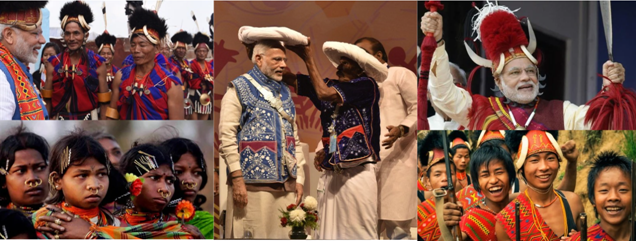
Despite their rich heritage, tribal communities were historically left out of the mainstream development narrative. For decades, they were seen more as custodians of culture than as equal partners in progress.
Under the leadership of Prime Minister Shri Narendra Modi, there has been a clear and deliberate shift from tokenism to targeted empowerment. The Union Budget 2025–26 marked a turning point, with a significant increase in funds for the Ministry of Tribal Affairs, reflecting the government’s commitment to inclusive growth that truly leaves no one behind.
Strengthening Budgetary Support for Tribal Development
Over the last decade, the Government of India has significantly increased financial allocations to promote the welfare of Scheduled Tribes. The Ministry of Tribal Affairs’ annual budget has tripled, rising from ₹4,295.94 crore in 2013–14 to ₹14,926 crore in 2025-26, demonstrating a strong commitment to inclusive growth.
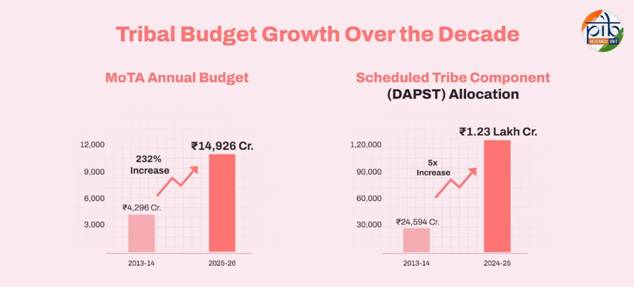
Major flagship schemes have received substantial funding, including ₹24,104 crore for PM-JANMAN and ₹79,156 crore for Dharti Aaba Abhiyan, aimed at the holistic development of tribal communities. Additionally, the Development Action Plan for Scheduled Tribes (DAPST) has seen a fivefold increase, from ₹24,598 crore in 2013–14 to ₹1.23 lakh crore in 2024–25, with 42 Union Ministries/Departments now contributing to ST-focused initiatives. This cross-sectoral approach ensures comprehensive and sustained progress in tribal education, health, infrastructure, and livelihoods.
Forest Rights Act: Securing Tribal Land and Livelihoods
The Forest Rights Act (FRA) empowers tribal and forest-dwelling communities by legally recognising their individual and community rights over forest land and resources. Over the past decade, the government has strengthened implementation through FRA cells in 17 states and 1 Union territory, capacity building, and awareness drives.
Under the Dharti Aaba Abhiyan, dedicated funding supports livelihood development and post-claim support. National-level meetings, including Manthan Shivirs and a District Collector/District Magistrates Conference in 2025, were held to fast-track claim processing and ensure on-ground action. The focus remains on securing land rights and enabling sustainable forest-based livelihoods.
Progress in Forest Rights Implementation
|
Particulars
|
Up to March 2025
|
|
Number of Titles Distributed to Individuals
|
23.88 Lakh
|
|
Number of Titles Distributed to Communities
|
1.21 Lakh
|
|
Claims Disposed
|
43.72 Lakh
|
|
Land Area Vested (in Acres)
|
232.66 Lakh Acres
|
Building a Future from the Ground Up
1. PM-JANMAN: A Lifeline for India’s Most Vulnerable Tribes
The Pradhan Mantri Janjati Adivasi Nyaya Maha Abhiyan (PM-JANMAN) is not just a scheme—it is a powerful mission of justice, dignity, and upliftment for India’s Particularly Vulnerable Tribal Groups (PVTGs). Launched with a vision of holistic development, this initiative is transforming lives in 75 PVTG communities across 18 states and 1 Union Territory, reaching the most remote corners of the country.
With a massive ₹24,104 crore investment, PM-JANMAN is bridging decades of neglect by ensuring access to the basics—housing, water, healthcare, education, nutrition, roads, and sustainable livelihoods—over a three-year period.
|
Ministry
|
Activity
|
Mission Target (2023–2026)
|
Sanctioned Details
|
Physical Achievements
|
|
Ministry of Rural Development
|
Provision of pucca houses
|
4.90 lakh houses
|
4,34,837 houses
|
1,04,688 houses completed
|
|
Ministry of Health and Family Welfare
|
Mobile Medical Units (MMUs)
|
733 MMUs
|
687 MMUs
|
687 MMUs functional with over 38 lakh footfalls
|
|
Ministry of Jal Shakti
|
Piped Water Supply
|
19,375 villages
|
18,379 villages
|
7,202 villages 100% saturated
|
|
Ministry of Women and Child Development
|
Construction and operationalisation of Anganwadi Centres
|
2,500 AWCs
|
2,139 AWCs
|
1,069 AWCs made operational
|
|
Ministry of Education
|
Construction and operationalisation of hostels
|
500 hostels
|
243 hostels
|
Work started in 95 hostels
|
|
Ministry of Communications
|
Installation of mobile towers
|
Coverage of 4,543 habitations
|
3,679 habitations
|
2,271 habitations covered
|
|
Ministry of Power
|
Electrification of unelectrified households
|
1,42,133 HHs
|
1,42,133 HHs
|
1,05,760 households electrified
|
|
Ministry of New and Renewable Energy
|
Solar power for households
|
As per identification of eligible beneficiaries
|
9,961 households sanctioned
|
2,057 households electrified
|
|
Ministry of Tribal Affairs
|
Establishment of Multipurpose Centres (MPCs)
|
1,000 MPCs
|
1,000 MPCs
|
Construction in progress in 612 MPCs; 38 MPCs completed
|
2.Dharti Aaba Abhiyan: Transforming Tribal Heartlands, Village by Village
In line with Prime Minister Narendra Modi’s vision of inclusive and holistic development, the Dharti Aaba Janjatiya Gram Utkarsh Abhiyan is a landmark initiative that ensures that governance benefits reach every tribal citizen. It reflects the Government of India’s unwavering commitment to Sabka Saath, Sabka Vikas, Sabka Vishwas, Sabka Prayas, and places tribal communities at the centre of India’s development journey.
Launched by the Ministry of Tribal Affairs on October 2, 2024, the Abhiyan builds on the success of PM-JANMAN and represents a powerful step towards transforming tribal villages into hubs of opportunity and dignity. With a significant investment of ₹79,156 crore, this multi-sectoral initiative brings together 17 ministries through 25 integrated interventions, offering a comprehensive model for grassroots development.
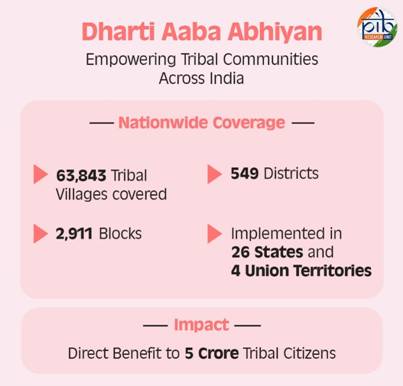
Guided by Antyodaya: Reaching the Last Person First
The Abhiyan embodies the principle of Antyodaya, ensuring that development reaches the most underserved and remote tribal communities. It addresses critical gaps in infrastructure and basic services by focusing on:
- Safe and permanent housing along with access to clean drinking water
- Improved healthcare and sanitation facilities
- Quality education and nutritional support for children
- Reliable electricity and promotion of renewable energy sources
- Road connectivity and expansion of digital networks in tribal areas
- Sustainable livelihood opportunities through convergence of schemes and skilling
Progress Highlights of Dharti Aaba Abhiyan
|
|
Area of Intervention
|
Targets & Achievements
|
|
Beneficiary Interventions
|
AWAS
|
11.45 lakh houses sanctioned and 76,704 houses completed.
|
|
Electrification
|
1,84,551 household electrification connections sanctioned and 3,827 public places sanctioned.
|
|
Drinking water supply
|
62,515 villages sanctioned and 25,870 villages saturated.
|
|
Agriculture support to FRA Patta holders
|
Proposals approved for 4 states Assam, MP, Odisha and J&K benefiting 1,73,097 beneficiaries.
|
|
Fish Culture Support to tribal fisherman
|
Proposals for support to tribal fishermen valued at ₹52.18 crore have been approved for 10 States/UTs: Assam, Jharkhand, Nagaland, Tripura, Goa, Madhya Pradesh, Maharashtra, Bihar, Chhattisgarh, Himachal Pradesh.
|
|
Community Interventions
|
Upgradation of Ashram Schools / Tribal Residential Schools
|
3,420 projects approved.
|
|
Tribal Multipurpose Marketing Centres (TMMCs)
|
71 TMMCs approved covering more than 5 lakh beneficiaries.
|
|
Centre of Competence (CoC) for Sickle Cell Disease
|
15 CoCs approved in 14 States.
|
|
Community Forest Resource Rights Management Plans (CFRM Plans)
|
920 CFRM Plans approved covering more than 90,000 hectares of forest land.
|
|
Dharti Aaba FRA Cells
|
17 State Level FRA Cells for 17 States/UT and 414 District Level Cells in 19 States/UT approved.
|
|
Mobile Medical Units (MMUs)
|
36 MMUs operationalised.
|
|
Hostels
|
604 hostels sanctioned.
|
|
Anganwadi Centres (AWCs)
|
236 AWCs sanctioned.
|
|
Telecom connectivity
|
4,543 villages sanctioned and 2,983 villages covered.
|
Janjatiya Gaurav Divas: Honouring Tribal Legacy
To celebrate the invaluable contributions of tribal communities to India’s freedom struggle and nation-building, the Government of India observes Janjatiya Gaurav Divas every year on 15th November, in memory of Bhagwan Birsa Munda. The 2024 celebration marked his 150th birth anniversary, and witnessed a nationwide outpouring of pride, participation, and policy-driven action aimed at preserving tribal heritage.
The 2024 Janjatiya Gaurav Divas saw massive virtual participation of over 1 crore people. A national event in Jamui, Bihar, was attended by the Hon’ble Prime Minister, underlining the significance of tribal contributions. To honour tribal heroes, 11 Tribal Freedom Fighter Museums were sanctioned across 10 states. Between 15–26 November 2024, more than 46,000 activities were conducted nationwide, covering themes like Education, Health, Livelihood, Art & Culture, and more. Programmes like Aadi Mahotsav and Dharti-Aaba TribePreneurs celebrated tribal talent, while 29 Tribal Research Institutes (TRIs) were engaged in organising festivals, seminars, and student-led events. National-level programmes were also held in Bihar, Nagaland, Goa, Kerala, Assam, and Mizoram.
Learning to Lead: Education that Empowers
The Eklavya Model Residential Schools (EMRS) initiative has undergone a significant transformation over the past decade, evolving into a flagship programme aimed at providing quality education to tribal students across India. The government’s strategic interventions in policy, infrastructure, academics, and digital innovation have vastly improved access, governance, and learning outcomes for tribal youth.EMRS schools are now set up in every tribal block with over 50% ST population and at least 20,000 tribal residents (per 2011 Census). TheMinistry has set the target to set up a total of 728 EMRS’s benefiting around 3.5 lakh ST students across the country.
Transformative Growth of EMRS (2004–2024)
|
Particulars
|
2004–2014
|
2014–2025
|
|
Total Schools Approved
|
90
|
555
|
|
Schools Functional
|
82
|
354
|
|
Buildings Completed
|
63
|
279
|
|
Recurring Cost per Student
|
₹42,000
|
₹1,47,000
|
|
Construction Cost per School (Plain)
|
₹12 Cr
|
₹38 Cr
|
|
Construction Cost per School (Hilly/NE/LWE)
|
₹16 Cr
|
₹48 Cr
|
|
Total Budget Allocation
|
Limited
|
₹28,920 Cr (2021–26)
|
|
Teachers & Non-Teaching Staff Recruited
|
Ad-hoc
|
9,000+
|
|
New Recruitment of Staff (2019–2026)
|
NA
|
38,480 approved
|
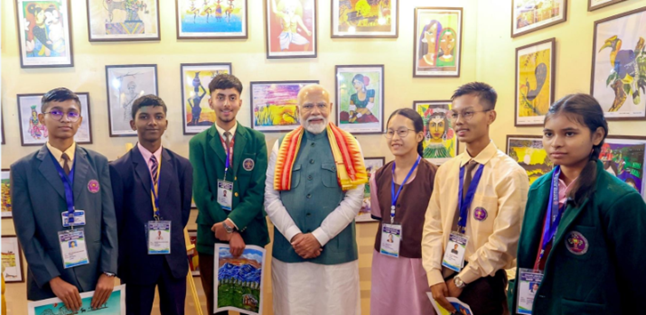
Empowering Tribal Students through Scholarship Schemes
Over the past 11 years, the Ministry of Tribal Affairs has significantly strengthened its scholarship ecosystem to empower tribal students through expanded coverage, increased funding, and digital transformation. Today, five central scholarship schemes benefit nearly 30 lakh tribal students annually, with a tripled budget outlay rising from ₹978 crore in 2013-14 to over ₹3,000 crore in 2024-25.
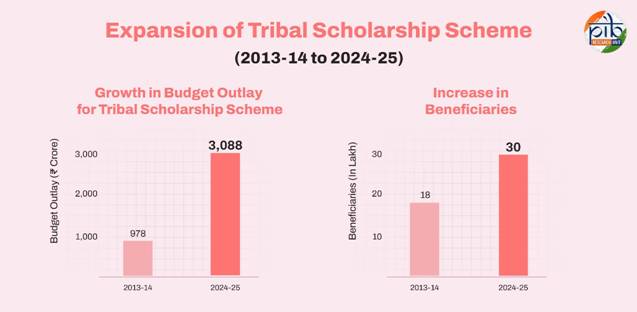
A key milestone has been the shift from manual to fully digital, Direct Benefit Transfer (DBT)-enabled systems, leading to faster, transparent, and real-time disbursal of over ₹22,000 crore in scholarships over the last decade. The number of students supported under various schemes has grown notably—MPhil/PhD fellowships rose from ~950 to 2,700, National Overseas Scholarships increased from 8 to 58 students, and Top-Class Education Scheme coverage more than doubled, benefiting 7,000 students in premier institutions like IITs, IIMs, and AIIMS.
Initiatives for Better Health Care for the Tribal Population
Sickle Cell Anaemia Elimination Mission
As part of its commitment to addressing health inequities among tribal populations, the Government of India launched the Sickle Cell Anaemia Elimination Mission in 2023. Announced in the Union Budget 2023–24 and formally launched by Prime Minister Narendra Modi on 1st July 2023 in Shahdol, Madhya Pradesh, this mission aims to eliminate Sickle Cell Anaemia (SCA) by 2047, with a focus on tribal-dominated regions.It aims to screen 7 crore individuals aged 0–40 years in tribal-dominated regions.
- By 2025, over 5 crore individuals have already been screened.
- A nationwide awareness campaign was conducted from 19 June to 3 July 2024, which included:
- 1.60 lakh events
- 1 lakh health camps
- Distribution of13.19 lakh screening cards
- A National Level Training of Trainers Programme was organised in January 2025 in Delhi to build capacity for SCA awareness and counselling.
- 15 Centres of Competence (CoCs) were established across 14 states under the Dharti Aaba Abhiyan to provide advanced diagnosis, treatment, and patient support.
|
AIIMS Delhi has played a pivotal role in advancing tribal healthcare through the establishment of the Bhagwan Birsa Munda Chair of Tribal Health with a focus on Hematology, the adoption of Lamtaput Block in Odisha for healthcare development, as well as support for mega medical camps like the one held in Sundargarh, Odisha during Janjatiya Gaurav Varsh.
This coordinated, multi-agency effort underscores the government’s resolve to ensure that tribal communities receive timely diagnosis, treatment, and care, thereby making health a key pillar of tribal empowerment and inclusion.
Tribal Livelihoods and Entrepreneurship
Van Dhan Ecosystem:
Launched on 14th April 2018, the Van Dhan Yojana is a flagship initiative under the 'Mechanism for Marketing of Minor Forest Produce (MFP) through Minimum Support Price (MSP) & Development of Value Chain for MFP.' Implemented by TRIFED as the nodal agency, the scheme aims to generate livelihood opportunities for tribal gatherers by transforming them into entrepreneurs. Van Dhan Vikas Kendras (VDVKCs) have been established in tribal-dominated districts, where tribal Self-Help Groups (SHGs) engage in the collection, value addition, and marketing of MFPs.
Key Transformational Achievements in Tribal Livelihoods and Enterprise
Empowering Tribal Entrepreneurs
- 4,030 Van Dhan Vikas Kendras (VDVKs) established across India
- Benefited over 12 lakh tribal individuals by generating sustainable livelihoods through value addition of forest produce
Expansion of Minimum Support Price (MSP) for Minor Forest Produce (MFP)
- 77 new MFPs added to the notified MSP list
- Ensured better price realization and income security for tribal gatherers
Strengthening Infrastructure and Market Linkages
- 1,316 Haat Bazaars, 603 storage units, and 22 processing units sanctioned
- Facilitated direct market access for tribal products and artisans
- ₹89.14 crore released to support tribal infrastructure development
Promoting Tribal Culture and Commerce
- 38 Aadi Mahotsavsorganised in major cities across the country
- Showcased tribal handicrafts, art, and agro-products to a wider national audience
High-Level Recognition and Support
- Prime Minister inaugurated Aadi Mahotsav twice, enhancing national visibility and support
- President of India addressed 15,000+ women SHG members in Jharkhand in 2023, empowering tribal women leaders
Financial Empowerment:
The National Scheduled Tribes Finance and Development Corporation (NSTFDC) has played a pivotal role in advancing the economic empowerment of Scheduled Tribes over the past decade. Operating under the Ministry of Tribal Affairs, NSTFDC has substantially scaled up its support to tribal entrepreneurs, students, and self-help groups through concessional financial assistance.
Between 2014 and 2025, the corporation has more than doubled its loan sanctions and disbursements, expanded its beneficiary outreach by over 95%, and extended coverage to 28 States and UTs. Its loan portfolio grew by 171%, while revenue and surplus tripled, indicating strong institutional growth and impact.
Policy Reforms and Strategic Initiatives (2014–2025)
- Enhanced Lending Limits
- Adivasi Mahila Sashaktikaran Yojana (AMSY): Loan ceiling raised from ₹50,000 to ₹2 lakh.
- Term Loan Scheme: Project cost ceiling increased from ₹10 lakh to ₹50 lakh per unit.
- Adivasi Shiksha Rinn Yojana (Education Loan): Limit increased from ₹5 lakh to ₹10 lakh.
- 139 tribal entrepreneurs honoured in Kohima and Vishakhapatnam under Azadi ka Amrit Mahotsav (2021).
- Over 650 ST womenSHG members trained in financial literacy, digital finance, and government scheme navigation.
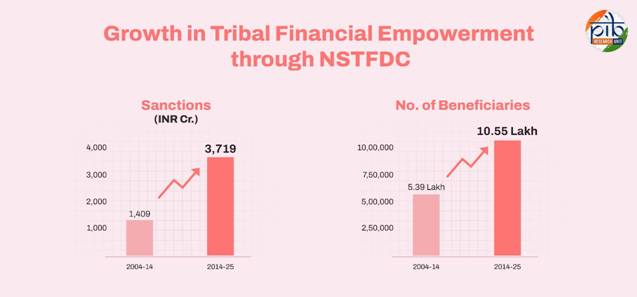
Startup & Innovation:
The Pradhan Mantri Janjatiya Vikas Mission (PMJVM) aims to boost tribal livelihoods by promoting enterprise development. It focuses on setting up Van Dhan Vikas Kendras and Producer Enterprises for value addition of Minor Forest Produce (MFP), strengthening MSP procurement, and developing Haat Bazaars and Warehouses to improve market access. TRIFED serves as the nodal agency, ensuring effective implementation and market linkages.
Key Transformational Achievements of PMJVM
|
Achievement Area
|
Details
|
|
Empowering Tribal Entrepreneurs
|
4,030 Van Dhan Vikas Kendras (VDVKs) established
Benefited over 12 lakh tribals
|
|
Expansion of MSP for MFPs
|
77 new Minor Forest Produce (MFP) items added to MSP list for better price realisation
|
|
Infrastructure & Market Linkages
|
1,316 Haat Bazaars sanctioned
603 storage units
22 processing units
₹89.14 crore released for infrastructure development
|
|
Promoting Tribal Culture & Commerce
|
38 Aadi Mahotsavsorganised across major cities
PM inaugurated Aadi Mahotsav twice
President addressed 15,000+ women SHG members in Jharkhand (2023)
|
Expanding the Scheduled Tribes List
The recognition of tribal communities has seen a remarkable rise, with 117 communities added to the Scheduled Tribes list between 2014 and 2024, compared to just 12 in the previous decade. This 10-fold increase highlights the government’s commitment to acknowledging previously marginalised groups and extending to them the benefits of development and welfare schemes.
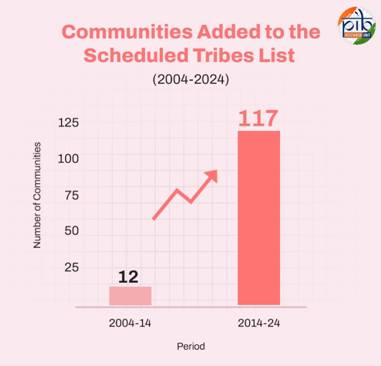
The inclusion in the Scheduled Tribes list opens doors to a wide range of welfare benefits for these communities, from educational and job reservations to political representation and legal safeguards, enabling their fuller participation in the nation’s development journey.
Conclusion: The Rise of Janjatiya Bharat
India’s tribal communities have moved from the margins to the mainstream, becoming central to the nation’s development journey. Through focused schemes like PM-JANMAN, Dharti Aaba Abhiyan, and the Van Dhan Yojana, the government has ensured that tribal citizens gain access to rights, opportunities, and dignity.This transformation goes beyond welfare, it is rooted in justice, empowerment, and inclusion. With investments in education, health, livelihoods, and culture, tribal communities are shaping their own future.This is the essence of Sabka Saath, Sabka Vikas, Sabka Vishwas, Sabka Prayas—a true Janjatiya Bharat in the making.
Reference:
Download in PDF
***
Explainer 13/ Series on 11 Years of Government
Santosh Kumar/ Sheetal Angral/ Anchal Patiyal
(Backgrounder ID: 154651)
आगंतुक पटल : 4683
Provide suggestions / comments